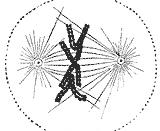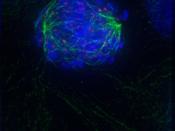Mitosis--which is a continuous process occurring in five stages: prophase, prometaphase, metaphase, anaphase, and telophase--is the division of the nucleus. During prophase, changes occur in the cytoplasm and the nucleus of the cell. Basically, in the nucleus, chromatin fibers become more tightly coiled-up, condensing into discrete chromosomes. Also, the nucleoli disappear. Each duplicated chromosome appears as two identical sister chromatids join together. Mitotic spindle begins to form in cytoplasm (it is made of microtubules radiating from two centrosomes). Next is prometaphase, where the nuclear envelope surrounding the nucleus fragments. Bundles of microtubules extend from each pole toward middle of cell. Kinetochore develops in centromere region of chromosomes. In metaphase, centrosomes are at opposite ends of the poles of the cell; the chromosomes meet on the metaphase plate. For each chromosome, the kinetochores of the sister chromatids are attached to microtubules coming from opposite poles of the cell.
Entire apparatus of microtubules = spindle. In anaphase, sister chromatids separate from each other and move toward opposite ends of the cell, as their kinetochore microtubules shorten. Thus, the two poles of the cell have equivalent and complete collections of chromosomes. Lastly, in telophase, nonkinetochore microtubules elongate the cell still more, and daughter nuclei form at the two poles of the cell. Nuclear envelopes arise from fragments. Mitosis--the equal division of one nucleus into two genetically identical nuclei--is finally complete.


